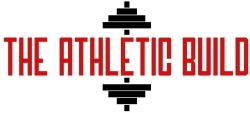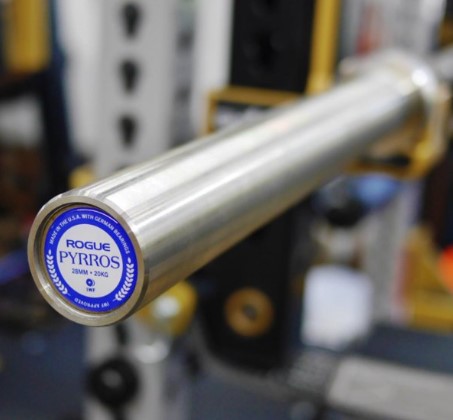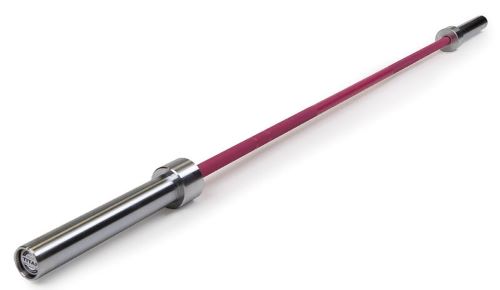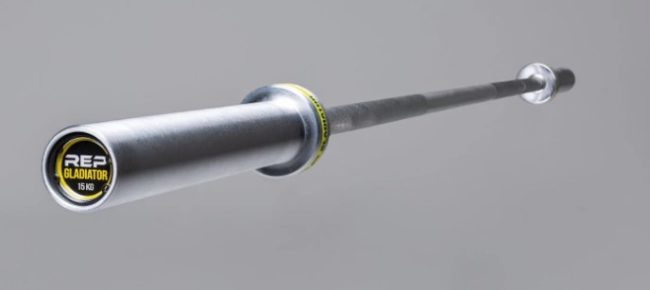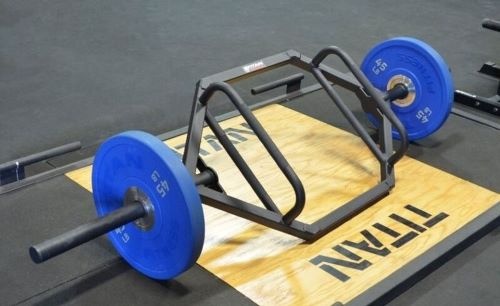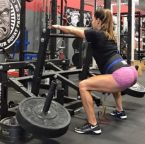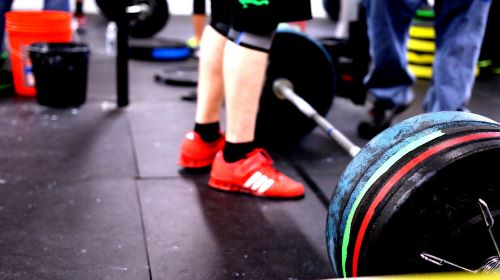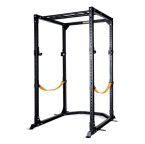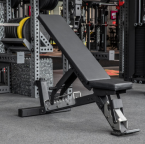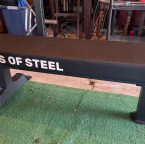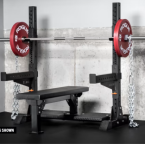A good barbell is more than just a piece of steel. It’s the backbone of your training, the thing you’ll grab for heavy squats, grinding deadlifts, and those late-night “just one more set” sessions.
The wrong bar will hold you back. It’ll bend where it shouldn’t, spin like it’s rusted shut, or feel cheap in your hands. But the right one? It’ll make every lift feel smoother, more stable, and like you’re actually getting stronger.
If your home gym is missing that one reliable, all-purpose bar, this list will help you fix that. Here are the best barbells worth loading up, no matter your budget or training style.
Best Barbells on the Market
- Best Barbell Overall – Gunner Barbell by ForceUSA
- Best For Olympic Lifting – The B.0.S. Bar 2.0
- Best On A Budget – The Economy Olympic Barbell
- Best High-End Barbell – Pyrros Bar (28mm)
- Best For Powerlifting – Powerlifting Barbell by ForceUSA
- Best Barbell For Deadlifts – Rogue Ohio Deadlift Bar
- Best Mutligrip Bar – Multi-Grip Swiss Barbell by Fringe Sport
- Best Barbell For CrossFit – Performance Training Barbell
- Best Hex Trap Bar – Walkthrough Trap Bar by Force USA
- Best Barbell For Women – TITAN Series Women’s Olympic Barbell
- Best Multipurpose Barbell – Multi-Purpose Olympic Barbell by Bells of Steel
- Best For Weightlifting – Gladiator Olympic Barbell by Rep Fitness
- Best Barbell On Amazon – Synergee Games Cerakote Barbell
- Best Barbell For Beginners – Sabre Bar by Rep Fitness
- Best Cerakote Barbell – Rogue Ohio Power Bar Cerakote
Gunner Barbell by Force USA
Best Barbell Overall
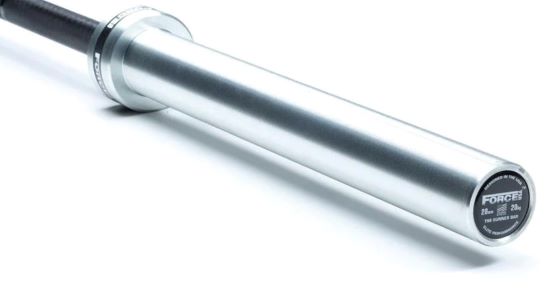
The Gunner Barbell from Force USA isn’t just another bar you toss on the rack. It’s the kind of bar you buy once and then stop thinking about because it quietly handles everything you throw at it. Squats, presses, pulls… it doesn’t flinch. Unless you’re chasing a world record deadlift or hauling stones in a strongman arena, this thing will cover your bases.
It’s built with dual knurling that meets both IPF and IWF standards, which basically means it’s comfortable in just about any lifting style. Grip marks are right where you want them, and the spin feels smooth without getting away from you. At 44 pounds with 235,000 PSI tensile strength steel, it’s strong enough to load stupid-heavy without even thinking about bending.
The sleeves come in black or bright zinc, and the stainless steel bush bearings give it a nice, reliable spin. No center knurling, which some people gripe about, but honestly, it saves your neck and shirt from getting chewed up. You might throw a pad on for squats, but that’s a small trade-off.
At 28mm in diameter and just under 87 inches long, with 16 inches of sleeve space per side, you can stack more plates than most home gyms will ever need. The zinc coating isn’t bulletproof, so keep an eye out for corrosion, but a little upkeep now and then keeps it looking sharp.
Bottom line, it’s a workhorse. The kind of bar that’ll quietly stick with you through years of training without letting you down.
Pros
- Very Versatile
- Stainless Steel Bushing For Great Spin
- Zinc Finish Is Pretty Good & Cuts Down On Price
- Has An Incredible 235,000 PSI
Cons
- While Zinc Is Great, It Can Rust If Not Careful
- Price Is Slightly On The Higher Side
- Only Available In The 20kg Size
The B.0.S. Bar 2.0
Best Barbell For Olympic Lifting
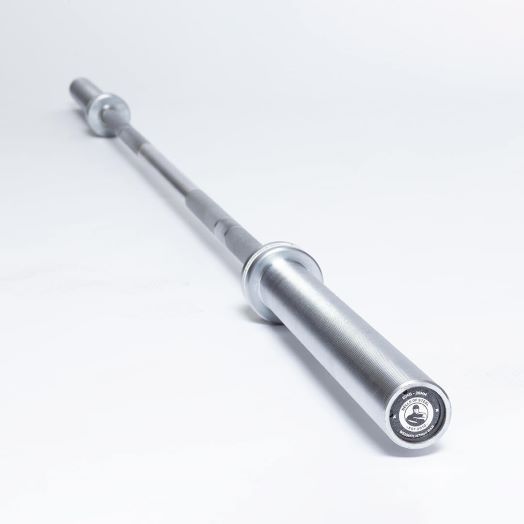
The Bar 2.0 from Bells of Steel comes out of Canada swinging. It’s the kind of bar that makes you stop mid-scroll and think, “Wait… how much?” because the price doesn’t match what you’re getting. Solid build, sharp knurling, smooth spin, all in a package that most brands would slap a way higher price tag on.
It’s made from stainless steel with a 240,000 PSI tensile strength and a 2,000-pound weight capacity. That means it’s tough as nails, with just enough flex to feel alive in your hands, but not so much that it whips around like a noodle. You can load it heavy, hit your lifts, and know it’s not going to tap out before you do.
The hardened chrome finish isn’t as flashy as a cerakote, but it’s plenty durable. It shrugs off rust and scratches like it’s no big deal. The knurling is on the aggressive side, which is great for Olympic lifts and presses, though you won’t find a center knurl here. You can squat with it if you want, but this bar feels more at home exploding overhead than sitting across your back.
Each sleeve has five needle bearings and a stainless steel bushing, giving you that smooth, quick spin that makes Olympic lifts feel clean. It stops just shy of spinning too freely, so you’re not fighting runaway plates mid-set. Machined sleeves keep everything locked in place so you can focus on moving weight, not chasing it.
All in, the Bar 2.0 feels like it punches way above its weight. It’s a lifter’s bar, built for work, and it just happens to be priced like it snuck past the accountant.
Pros
- Free Shipping
- Great For Olympic Weightlifting
- Offered At A Super Reasonable Price
- Ideal For Secure Holds As Well As Lifts Or Presses
- Chrome Finish Makes It Highly Resistant To Rust
- Machined Sleeves Prevent Weight Plates From Slipping
Cons
- No Center Knurl Makes Squats A Little More Difficult
- No Different Colors Or Logo Capabilities
- Knurl Isn’t IWF-Approved
The Economy Olympic Barbell by Titan Fitness
Best On A Budget
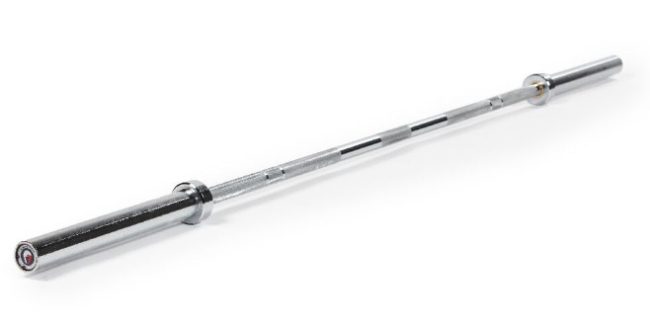
If you want to start lifting but your wallet isn’t ready for a premium bar, the Titan Fitness Economy Olympic Bar is an easy win. It’s not going to flex on the high-end models in this list, but it’ll get the job done without draining your bank account. Sometimes, that’s exactly what you need to get moving.
At 45 pounds and 84 inches long, it’s got the size and feel of a standard Olympic bar. Sixteen inches of loadable sleeve space on each end gives you plenty of room for plates, and the 30mm diameter feels solid in the hands. The knurling runs 16 inches on both sides with another 8 inches in the center, giving you good grip no matter the lift.
The diamond-style knurling is paired with a chrome finish, which helps fight off rust. You’ll still want to check it once in a while, but it’s low-maintenance. The 2-inch sleeve diameter works with any standard Olympic plates, and the bar’s cold-rolled steel build makes it tougher than the cheaper hot-rolled options out there. With a 700-pound weight capacity, it’s stronger than most beginners will ever need.
Sure, it skips a few fancy details, but that’s not the point here. This is a straightforward, no-excuses barbell that can handle squats, deadlifts, presses, and whatever else you throw at it. If you’re ready to start training without overthinking your first bar, this is where you start.
Pros
- Super Affordable
- Has Center Knurling
- Made From Cold-Rolled Steel
- Can Handle 700lbs Of Weight
- Built Per Olympic Standards
Cons
- Knurling Is A Bit Aggressive
- Bar Diameter Is Slightly Larger Than Olympic Standards
- Spinning Isn’t Particularly Exceptional
Pyrros Bar (28mm) by Rogue
Best High-End Barbell
Some barbells are good. A few are great. And then there are the ones that feel like they were built for champions. The Rogue Pyrros 28mm Barbell falls right into that last category.
This isn’t just a hunk of steel with some knurling on it. It’s an IWF-certified stainless steel bar, built in collaboration with Olympic weightlifting legend Pyrros Dimas. The guy has three gold medals and a bronze, so when he puts his name on a bar, you know it’s the real deal.
At 44 pounds and 28mm in diameter, it’s built to exact Olympic standards. Eighty-six inches end to end, with a center knurl for squats, and balanced perfectly for the kind of precision lifting that wins medals. The certification means it’s ready for international competition, but it also means you’re getting a bar with craftsmanship that most lifters will never touch.
The spin is where it really shines. Rogue went with bearings instead of bushings, which makes a world of difference on snatches, cleans, and jerks. The sleeves move smooth and fast, so you can turn over lifts without fighting the bar. If you live for Olympic lifting, that detail alone is worth it.
The Pyrros Bar isn’t cheap, and it’s not trying to be. It’s built for lifters who care about every rep, every grip, every ounce of performance. If that sounds like you, this bar will feel like home the first time you rack it.
Pros
- Very Strong & Durable
- Has Great Spin
- Stainless Steel Makes It Rust And Corrosion-Resistant
- Fully IWF-Certified
- Has A Lifetime Warranty
Cons
- On The Pricier Side
- Not Ideal For Powerlifting Or CrossFit
- Knurling May Be A Bit Too Aggressive For People Starting Out
Powerlifting Barbell by Force USA
Best For Powerlifting
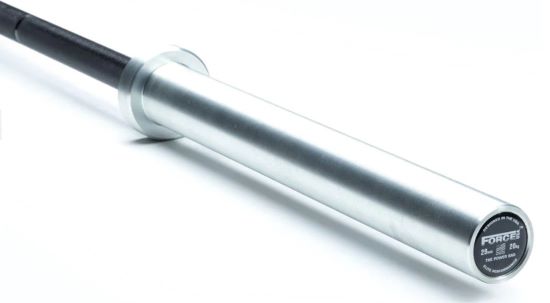
The Force USA Powerlifting Barbell isn’t here to play nice. This is a commercial-grade, heavy-hitting bar built for lifters who don’t just load the bar… they try to break it. And the thing is, it won’t.
With a 200,000 PSI tensile strength and a 2,000-pound weight rating, this bar laughs at loads that would make lesser bars cry. It’s rigid, it’s unshakable, and it’s built to keep its shape no matter how much iron you throw on.
At 45 pounds and 86.6 inches long, it’s sized right for serious power work. The 29mm diameter feels solid in your hands, and the 0.45mm deep knurling bites just enough to lock in your grip without tearing you up. Whether you’re walking out a monster squat or pulling heavy from the floor, it stays steady and predictable.
The stainless steel bearings give you a smooth, controlled spin, enough to help with the lift, but not so much that it throws you off. The sleeves are zinc-coated for strong corrosion resistance, sitting just under stainless steel and cerakote in terms of protection, which means it’s built to last even with years of hard training.
This bar was made for one thing: moving big weight, over and over again. If your idea of a good time is testing your limits and leaving the rack groaning, this is the bar you want on your back and in your hands.
Pros
- Very Durable
- Incredibly Impressive Weight Bearing
- Zinc Coating Makes It Very Smooth
- Perfect For Powerlifters
Cons
- Knurling May Be Slightly More Aggressive
- Not Ideal For CrossFit
#6. Rogue Ohio Deadlift Bar
Best Barbell For Deadlifting
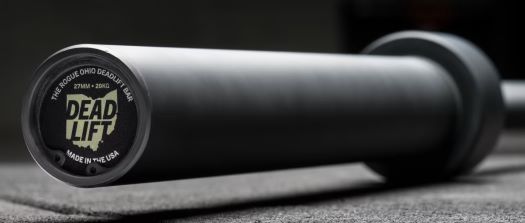
The Rogue Ohio Deadlift Bar is built for one thing, pulling big weight off the floor. Slightly thinner and longer than a standard bar, it’s got that perfect mix of bend and whip that lets you load it heavy and still feel smooth off the ground. Rogue’s signature attention to detail is all over this thing, making it a deadlifter’s dream.
At 44 pounds and 27mm in diameter, it’s slimmer than a regular bar, which means you can wrap your grip tighter and hang on longer. The extra length, 90.5 inches versus the standard 86.5, gives you more flex, so the weight comes up in a way that feels almost forgiving… until it’s not. With a 190,000 PSI tensile strength, it’s more than tough enough to handle whatever you stack on it.
The dual aggressive knurling on each side locks your hands in place, exactly what you want when you’re moving big numbers. You can get it in zinc or raw steel, and the 15.5 inches of sleeve space gives you plenty of room for plates. Bronze bushings keep the sleeves stable without too much spin, which is perfect for deadlifts, no wobble, no surprises.
This isn’t a bar for everything. It’s a bar for lifters who live for that moment when the plates clear the floor and the room gets quiet. If that’s you, the Ohio Deadlift Bar delivers.
Pros
- Excellent Whipping For Full Deadlift Range Of Motion
- Great Length
- Good Amount Of Free Space To Load Weights
- Aggressive Knurl Makes It Great For Deadlifting
Cons
- A Bit On The Louder Side
- Not Great For Beginning Deadlifters/Powerlifters (Needs At Least 225lbs For Proper Use)
- Shouldn’t Be Used For Squats
Multi-Grip Swiss Barbell from Fringe Sport
Best Multi-grip Bar
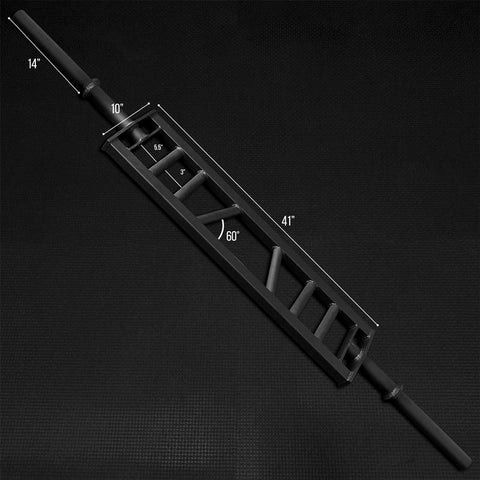
The swiss barbell isn’t the kind of thing you see every day in a gym. It looks different, feels different, and honestly, most people don’t even know what it’s for. But once you get your hands on one, it clicks. Suddenly your presses feel smoother, your shoulders aren’t barking at you, and you’re hitting muscles from angles you didn’t even think about before.
Fringe Sport’s Multi-Grip Swiss Bar is one of the best versions out there. The big draw? Options. You get three neutral grip positions, each one opening up a different set of possibilities. Bench presses, hammer curls, skull crushers, front raises… they all feel fresh and joint-friendly. That neutral grip takes the strain off your shoulders and wrists, so you can push heavier without feeling like you’re grinding your joints down. Flip it over and you even get a fourth grip angle to mess around with.
At 46 pounds and 82 inches long, with 14-inch loadable sleeves on each side, it’s built to hold plenty of weight. The grips are spaced at 8.5, 18.5, and 27.25 inches, giving you a solid mix of narrow, standard, and wide options. The knurled handles are just right, not cheese-grater aggressive, but enough to keep the bar locked in even when your hands are sweaty. The powder coat feels smooth, but still gives you that reassuring bite when you grip it.
Now, it’s not perfect. You’ll need a rack that’s about 49 inches wide to load and unload it comfortably, so a narrow rack will fight you. And the sleeves aren’t Olympic-sized, so it’s not something you’ll be competing with. But for pure training, for building strength without beating yourself up, this thing’s a monster in the best way possible. It’s the kind of specialty bar that earns its spot in your lineup.
Pros
- Multiple Grip Options
- Knurled Handles
- Weight Capacity Over 1,000lbs
- Surprisingly Affordable Considering What It Offers
Cons
- Powdercoat Finish Can Get Scuffed Fairly Easily
- Is Difficult To Rack Compared To Other Bars
- Sleeves Not Olympic-Sized
Performance Training Barbell by American Barbell
Best Barbell For CrossFit
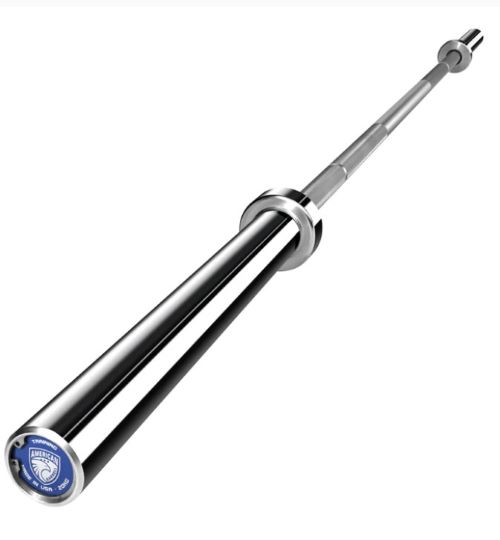
The Performance Training Bar isn’t just another barbell on the wall. This is the kind of bar you grab when you want something that can keep up with every workout you throw at it. CrossFit, Olympic lifts, heavy training days, it doesn’t care. It just delivers. American Barbell has built a name for making gear that feels right in your hands and lasts, and this bar is no exception.
At 46 pounds and built from precision ground alloy steel, it’s got the strength to handle years of abuse. The chrome coating keeps it looking sharp while the 190,000 PSI tensile strength gives it just the right mix of stiffness and whip. You can feel it when you pull; it responds without feeling sloppy.
The 28mm shaft runs on composite bushings, which might sound like a downgrade if you’re used to bearings, but here’s the thing: they’re thick, smooth, and shockingly close to mid-grade bearings in performance. It’s not a bar that spins wildly when empty, but load it up and it rotates exactly when you need it to. Smooth, controlled, dependable.
The knurl is light and finely cut, so you can move through a ton of reps without shredding your hands. It’s comfortable for high-volume CrossFit work but still grippy enough for heavier Olympic lifts. This is the bar you keep reaching for because it just works, day in, day out, no fuss, no drama, just performance.
Pros
- Hard Chrome Coating Is Reasonable For Rust & Abrasion Protection
- Has Very Fine & Light Knurl Patterns
- Super Versatile
- Great For CrossFit Along With Other Fitness Exercises
- Great For Beginners & Intermediates
- Very Well Made
- Great Olympic Weightlifting Barbell
Cons
- Price Is Certainly On The Higher End
- While Bushings Are Great, They Aren’t Bearings
Check Price
Walkthrough Trap Bar by Force USA
Best Hex Trap Bar
The trap bar is one of those pieces of equipment that makes people stop and stare the first time they see it. Hexagonal shape, open frame, big solid handles, it doesn’t look like your standard barbell. But once you get under it, you realize it’s one of the most joint-friendly, functional tools you can have in a gym. And Force USA’s Walkthrough Trap Bar takes that idea and pushes it even further.
This thing is built like it means business. It weighs in at 65 pounds and can handle up to 661 pounds without flinching. At 69 inches long with 12.8-inch loadable sleeves, you’ve got room to stack plenty of plates. The walkthrough design isn’t just a cool look; it makes loading, unloading, and getting into position way easier than with old-school trap bars.
Assembly is quick, maybe 20 minutes tops unless you’re overthinking it. Once it’s ready, you can knock out high or low deadlifts, carry work, lunges, and even grip-strength builders. The neutral handles take a lot of stress off your lower back and shoulders, which means you can go heavy without feeling like you’re wrecking your joints.
It’s not the bar most people imagine when they think “barbell,” but that’s exactly why it’s so good. It’s like having a built-in spotter and a form coach in one piece of equipment. If you train hard and want a tool that makes heavy work feel smoother, this is one worth putting in the lineup.
Pros
- Extremely Versatile
- Can Add Multiple New Exercises
- Makes Lifting With Partners Easier
- Knurling Isn’t Particularly Aggressive
Cons
- Doesn’t Have A Particularly High Weight Bearing Capacity
- Is A Bit Heavier Due To The Extra Equipment
- Does Require Assembly
Related: Best Hex/Trap Bars on the Market
TITAN Series Women’s Olympic Barbell
Best Barbell For Women
A lot of bars out there are clearly made with men in mind, but that doesn’t mean women don’t have serious options. Titan’s Women’s Olympic Barbell is built for lifters who want a bar that feels right from day one and still keeps up years later. Whether you’re just learning your way around a platform or you’ve been training hard for a while, this one earns its spot.
It comes in at 33 pounds and measures just under 80 inches, with a comfortable 25mm shaft that feels great in the hands. You get just over 11.75 inches of loadable sleeve space on each side, which is more than enough for the kind of work most lifters will throw at it. The 52 inches between sleeves gives you plenty of room for presses, pulls, and just about any Olympic lift you can think of.
The dual knurl marks give you clear grip reference points, and the cerakote finish isn’t just there for looks. It’s tough, resistant to rust, and shrugs off scratches better than most finishes out there. Bronze bushings keep the spin smooth and controlled, not as wild as top-end bearings, but consistent and reliable when you’re turning the bar over.
The knurling is moderate, so you can work through high-volume sessions without shredding your hands, but it’s still grippy enough to feel locked in on heavy lifts. With a tensile strength of 190,000 PSI and a 1,500-pound capacity, this isn’t some “light use only” bar. It’s built to handle whatever you’ve got. If you want a bar that works as hard as you do and doesn’t quit, this is it.
Pros
- Uses Cerakote For Sleeve Coating
- Knurl Isn’t Too Abrasive
- Offers A Weight Capacity Of 1,500lbs
- Great For Lifts & Presses
- Offered In Multiple Colors
- Can Be Used In CrossFit
Cons
- Uses Bushings Rather Than Bearings
Multi-Purpose Olympic Barbell by Bells of Steel
Best Multipurpose Barbell

A lot of barbells claim to be versatile, but most of the time they’re just decent at a few things. A true multi-purpose bar is different. It’s the one you keep reaching for because it feels right on squats, presses, pulls, whatever you throw at it. Bells of Steel didn’t just make one of those bars. They made one that punches way above its price tag.
This one comes in at 44 pounds, stretching 86.6 inches with 16.25 inches of loadable sleeve space on each side. The distance between sleeves is 51.5 inches, giving it the right feel for both Olympic and powerlifting movements. With a tensile strength of 190,000 PSI, it’s tough enough for heavy training but still has a nice whip when you need it.
The 28.5mm shaft has both dual knurl marks and a center knurl, so you’re covered whether you’re hitting cleans, benching, or settling in for a set of back squats. The knurling itself is middle-of-the-road, secure without chewing your hands up, and has just enough depth to keep your grip locked without feeling sharp. That makes it great for high-rep work like CrossFit or conditioning sessions where your hands take a beating.
It’s finished in black zinc, which looks sharp and keeps the price down. Sure, it’s not as premium-feeling as stainless and it can chip or rust if you neglect it, but keep up with a little maintenance and it’ll stay in great shape. Bottom line, this is a bar that does just about everything well, doesn’t cost a fortune, and will probably become the one you grab for most of your workouts.
Pros
- Very Affordable
- Knurl Is Not Too Aggressive
- Can Definitely Stack On The Weights Without Too Much Of An Issue
- Has A Pretty Good Spin
- Has A Max Weight Capacity Of 1,000lbs & A Tensile Strength Of 190,000lbs
Cons
- Uses A Zinc Finish
- Bronze Bushing Does Result In Spin That Isn’t What It Could Be
- Some Note The Knurl Not Quite Tracking
Gladiator Olympic Barbell by Rep Fitness
Best For Weightlifting
If your main goal is to get better at weightlifting, a lot of the other bars out there might feel like they’re not quite built for you. The Gladiator Olympic Barbell from Rep Fitness is different. This is the kind of bar that feels like it was made for serious lifters, the ones chasing precision, heavy numbers, and that perfect pull.
It weighs in at 44 pounds with a 28mm shaft, giving it the right feel for Olympic lifts. You get dual knurl marks for clear grip positioning, but no center knurl. That means back squats won’t have quite the same grip on your shoulders, but it also saves your skin and shirts from getting chewed up. The knurl itself is mild, which makes long sessions easier on the hands, though some lifters might wish it bit a little harder given the kind of weight this thing can handle.
And it can handle a lot. We’re talking up to 1,500 pounds with a ridiculous tensile strength of 230,000 PSI and a yield strength of 210,000 PSI. This is a stiff bar; there’s barely any whip, so what you put into it is exactly what you get back. Some lifters will love that stability, others might miss a little more flex.
The hard chrome finish is built to hold up under abuse and does a great job resisting rust and corrosion. Pair that with its smooth 5-needle bearing system, and you’ve got a bar that rotates beautifully under load without feeling sloppy. It’s strong, stable, and built for serious weightlifting work. If you want a bar that will keep up with your heaviest days and your most technical lifts, the Gladiator is one to look at.
Pros
- Has Over 230,000 PSI Tensile Strength & 210,000 Yield Strength
- Can Bear Upwards Of 1,500lbs
- Uses Hard Chrome Coating
- Has 5-Needle Bearing For A Smooth Spin
- Knurling Isn’t Particularly Aggressive
- Perfect For Weightlifters & Deadlifters
- Super Durable
Cons
- Not The Best For Squats Compared To Others
- Knurl May Not Cut, But It May Be A Bit Too Soft (Can’t Quite Connect)
- Doesn’t Have Any Whip
Synergee Games Cerakote Barbell
Best Barbell On Amazon
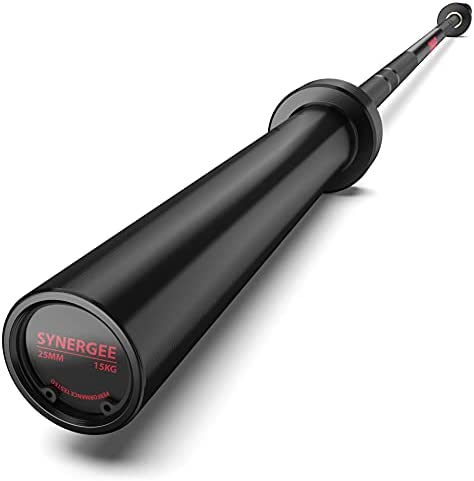
Amazon is packed with barbells, but let’s be honest, most of them are garbage. They look the part, maybe even feel decent at first, but over time you realize they’re just filler. The Synergee Games Cerakote Barbell is different. This is one of those rare finds that actually delivers on quality, versatility, and price all at once.
The cerakote finish isn’t just for show. It’s tough, it resists wear, and it’s going to keep this bar looking and performing great even after countless sessions. Whether you’re hammering out CrossFit WODs, chasing PRs in Olympic lifts, or just getting solid training in week after week, this bar keeps up without complaint.
It comes in 15kg and 20kg options, available in black, pink, or red. With a 190,000 PSI tensile strength and a 1,500-pound weight capacity, you can load it heavy for squats, presses, or pulls without worrying about it bending out of shape. The 28mm shaft has dual knurl marks and no center knurl, which makes it comfortable for high-volume work while still giving you the grip reference you need.
Is it going to beat out the Rogue Cerakote Ohio Bar? Not quite. But here’s the thing, it gets close, and it does it at a price that makes you look twice. For lifters who want a bar that can handle just about anything without draining the bank account, this is one of the smartest buys on Amazon.
Pros
- Super Reasonable Price Tag
- Cerakote Shaft Makes It Abrasion-Resistant
- Great For CrossFit
- Dual Knurling For Lifts & Presses
- 10 Needle Bearings For Faster Spinning Sleeve
Cons
- A Bit Too Thin For Super-Heavy Lifting
- No Center Knurl Makes It Not Ideal For Squats
- Cerakote Sleeves Actually Scar Up Faster Than Other Materials
Sabre Bar by Rep Fitness
Best Barbell For Beginners
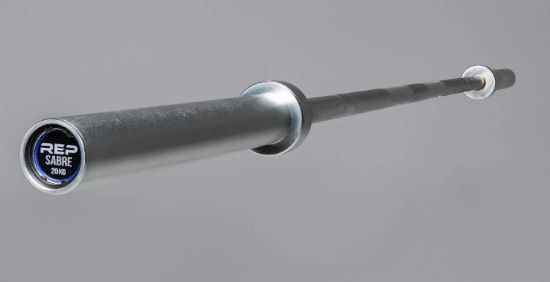
Some barbells on this list are built like high-performance sports cars, incredible in the right hands, but a little intimidating if you’re just learning to drive. That’s where the Sabre Barbell from Rep Fitness comes in. It’s made for beginners who want something straightforward, but still good enough to grow with as their training gets more serious.
This bar can take a beating. You can rack it, un-rack it, drop it, and it just keeps coming back for more. The knurling is light, which means it won’t shred your hands while you’re figuring out your form, but it still gives enough bite to keep the bar secure when you need it.
You can grab it in either 15kg (33lb) or 20kg (45lb) versions, with a choice between a standard or black zinc finish. That black zinc not only looks sharp but also helps fend off rust and scratches. The 20kg version even offers a center knurl option, though for most beginners and CrossFit-style training, skipping it keeps things more comfortable.
It’s rated for up to 1,000 pounds with a tensile strength of 150,000 PSI. For a beginner, that’s more than enough. At 28mm in diameter with 16-inch sleeves and a full length of 87.4 inches, it feels like a proper barbell without being overbuilt or overly stiff. As you progress, you might eventually want something with higher tensile strength, but until then, this is exactly the kind of bar that lets you focus on getting stronger without overthinking your gear.
Pros
- Super Affordable
- Great For Beginners
- Knurling Is Very Light Compared To Others
- Very High Quality
- Can Accept A Lot Of Punishment
- Has Optional Center Knurling
- More Durable Than The Rep Basic Barbell
Cons
- May Not Be Ideal For Those That Want A More Aggressive Knurl
- The Zinc Finish Isn’t Quite As Good As Stainless Steel
- 150,000lbs Tensile Strength Isn’t A Lot For Trained Athletes
Rogue Ohio Power Bar Cerakote
Best Cerakote Barbell
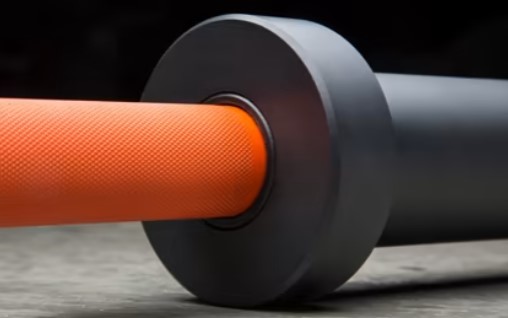
Rogue’s Ohio Power Bar has always been a powerhouse, but the Cerakote version takes it to another level. It’s the kind of bar that feels just as at home under a max-effort squat as it does in a clean and press session. If you want one bar that can handle shifting goals, changing programs, and whatever else you throw at it, this one makes a strong case.
Cerakote isn’t just a fancy paint job. It’s a ceramic-based finish that’s insanely tough, about a hundred times more abrasion-resistant than Rogue’s other coatings. That means it holds up against chalk, plates, racks, and the grind of daily training better than almost anything else out there. If you can swing the extra $40 over the standard finish, it’s worth it.
The bar comes in at 20kg with a 28.5mm shaft, dual knurl marks, and no center knurl. That makes it comfortable for Olympic lifts while still giving you the grip reference you need for power work. The knurl itself has that classic Rogue balance, sharp enough to lock you in, but not so aggressive it shreds your hands after a long session.
With 190,000 PSI tensile strength, you can load it heavy without even thinking about bend or break. The 16.25-inch sleeves give you plenty of room for plates, and at just over 86.5 inches total, it fits standard racks perfectly. It’s tough, it’s versatile, and it’s built to outlast you, exactly what you want from a bar you plan on using for everything.
Pros
- Cerakote Coating Is Super Durable
- Rogue Offers Lifetime Warranty Against Bending
- Super Versatile
- Dual Knurling Is Great For Most Lifts
- One Of The Best Squat Bars Out There
Cons
- Cerakote Is An Additional Price Instead Of Included
- Not A Ton Of Color Options
- Has Rogue Branding, Making It Potentially Annoying For Some People
How We Decided the Best Barbells for Home Gyms
It’s not an easy task to test barbells. We take our time and always make sure that we get it right, considering how the weight will feel when you lift them; whether or not they can withstand heavy use in different environments (from home workouts); as well as what price range would suit your needs best.
Type of Lifting You Are Doing
The most important thing to consider when testing a barbell is what it’s designed for. While all of them can be used in multiple ways, some may have been created with one specific sport or lift style in mind – like trap bars which are typically only meant for deadlifts and farmers’ carries. We make sure our experience matches up accordingly by training using the notes provided by the manufacturer before ranking each item on the list according to its purpose.
We test a company’s advertising claims to see if they can create an accurate portrayal of their product. For example, if the sleeve spin on your Olympic barbell is barely noticeable, then this might not rank so well with consumers who want more motion from their weightlifting bars and prefer smoother bearings during workouts as well as increased durability over time due in part because these types often have aggressive knurling which provides enough grip without being too uncomfortable for long periods.
Durability
We assess how the barbell holds up over time in our gym, then we look at intricate factors that no one considers but make a huge difference! Oftentimes when assessing the durability of bars, simply by looking at their specifications can give you an idea about whether or not they will last given enough use. For example, if there’s nowhere for dirt particles to settle on top due to clean surfaces without getting stuck between threads – which would cause rusting faster than normal.
The type of bearings used in barbells can make a world difference when it comes to durability. Needle-type bearings have smoother spins, but they’re more expensive and prone to break easily, whereas ball or bushing styles are fewer caretakers; generally speaking, these will last longer even if you drop your weights on occasion.
Price
Let’s be honest, unless you are Elon Musk the price is going to matter. We consider the price of a barbell when selecting which one to buy. Bar prices can range from around $150 for an under-$300 model all the way up into high competition class with costs ranging upward at about 1000 dollars or more.
We make sure these bars don’t just have expensive features without reason behind them – like quality, specification/approval by IWF/IPF standards and durability- so you’re getting your money’s worth regardless if it is on budget constraints or not.
Different Types of Barbells
As you can probably tell, there are a variety of different barbells on the market, many of which look and operate very differently from what you’re maybe used to seeing at the gym. Below, we’ll go over several of the more well-known types of barbells, some specialty bars, and how they operate. That way, you’ll be better informed when determining which will work best for you and what you’re trying to focus on.
The Standard Bar
Known as the standard for a reason, the standard barbell is probably what most people think about when they think of a barbell. They’re the most common type of barbell found in commercial gyms and can be used for just about any type of lift.
Standard barbells tend to weigh between 44 and 45lbs and are generally made from coated steel. They are generally engraved with knurling (the etched surface used for gripping) and are considered the basis from which all other barbells are derived.
The Axle Bar
The axle barbell stands out primarily for its incredible thickness. Compared to most barbells out there, which generally can only reach between 1 and 1.15 inches in diameter, axle bars are often easily at a full 2 inches, making them wholly unique in the barbell landscape.
Because of their large diameter, axle bars are great for improving and developing your grip strength while also being a more challenging barbell for performing deadlifts due to their lack of bend or “whip”.
Unless you are at a specialty gym, it’s unlikely you’ll come across axle bars. These are most often seen at performance gyms or very specific strongman competitions.
The Cambered Bar
Cambered barbells are also known as “EZ-grip” bars. This is due to their signature “bent” appearance. These barbells are specifically designed around offering a comfortable lifting experience for the wrists and elbows while their ergonomic handles make holding onto them much easier compared to standard bars. Compared to standard barbells, cambered bars are ideal for those with more sensitive wrists or who are suffering from intermittent elbow pain.
Because of their bent shaft appearance, cambered bars are generally going to be a bit shorter compared to standard or Olympic bars. The good news is that you can find them in most gyms with either fixed or loadable weights.
The Duffalo Bar
Developed by the powerlifter Chris Duffin, the Duffalo bar is not too dissimilar from the standard barbell. The only real difference is its respective shape. Unlike standard bars, which are straight all the way through, Duffalo bars have a slight curve that runs across their shaft.
Duffalo bars are fairly common in most gyms, with the curve allowing users a greater range of motion when performing a bench press. This is because the arm can sink deeper behind the torso before the bar itself reaches the chest. The Duffalo bar is also great for squats, as it offers a more comfortable grip and allows for an easier time achieving a low-bar position.
The Elephant Bar
Elephant bars are probably one of the barbells you’ll never see outside of very specific strongman competitions. Created by the Arnold Classic strongman competition’s supplier, Rogue Fitness, the Elephant bar is intended to carry an extreme amount of weight while not giving when lifted.
Elephant bars are defined by their elongated shafts while also holding thicker and larger weight plates on either end. Both of these things work to give the barbell that signature “bendy” nature when being lifted. In fact, because of the flexibility of the shaft and the incredible weights being loaded, most users will have to “pull” on the weight quite a bit before the weights manage to lift off of the ground. This makes fully extending your knees and hips easier and allows for a full range of motion.
The Fixed Bar
Fixed barbells are similar to standard barbells with the exception being that their weights are preestablished. This makes them much more convenient and easier to get used to compared to loadable weight bars. On the other hand, these lose the customization factor, essentially making it harder to progress unless you get an entirely separate fixed bar.
Fixed barbells are similarly found in most gyms and often exist along 10lb increments (10,20,30,40lb etc). They are a great option for those that are beginners and find themselves a bit too intimidated by standard barbells.
The Log Bar
Log bars are well-known thanks to their particularly unique look. Like axle bars, log bars are distinct for their use in strongman events and competitions. Here, they are essentially large steel cylinder that has two holes for you to place your hand where, inside, there is a neutral-grip handle.
Log bars are great for those that want to stress their muscles. They are commonly used for overhead presses as well as push presses.
The Olympic Bar
The Olympic barbell works slightly differently compared to powerlifting bars or standard bars. These barbells are generally a bit on the thinner side, weighing around 44lbs while measuring out between 1.06 inches and 1.14 inches.
Olympic barbells are noteworthy due to their fluid spin motion. This spinning allows users to quickly turn the hand over, performing a super clean snatch. They tend to have knurling in their center and are often meant to rest on the collarbone when performing squat lifts or squat presses.
The Powerlifting Bar
The powerlifting bar or power bar is, as the name implies, meant primarily for powerlifters. These barbells are especially rigid and offer almost no bend (with slight exceptions for deadlifters). These barbells tend to have knurling at their center to better secure the upper back for squat lifts.
The Safety Bar
Safety squat bars, like cambered bars, are built primarily around support and comfort. In this case, safety bars are ideally meant for those that are suffering from restricted shoulder mobility or otherwise may find placing a barbell on your upper back to be too challenging.
These barbells have separate handles that are attached to the bar itself. These handles will normally sit along the back while having some type of padding for the neck. All of this works to have an easier time performing squats while also straining your back and neck as little as possible.
The Swiss Bar
Swiss barbells often provide some of the most variety when it comes to grip positions. Rather than only a single long shaft, Swiss bars will usually have several different handles available, all of which offer a different angle setup.
Swiss bars, while not everywhere, are great for those that may be suffering from an injury or interested in stimulating a different part of the chest or shoulders. They come in a variety of different sizes and lengths, with smaller versions being ideal for hammer curls.
The Trap Bar
Trap barbells are aptly named, coming in the form of hexagonal “traps” which hold your entire body inside. Or is it because they are great for working your traps?
Here, the handles are located adjacent to your legs and are primarily used to shift the location of the weight relative to one’s gravitational center.
Rather than having the resistance at your midline, the trap bar works to improve your leverage, thus bringing the resistance even closer to you. These barbells are generally more comfortable and easier to operate than standard bars while also being great for loaded carries, making them exceptional when it comes to conditioning-based workouts.
The Tsunami Bar
The Tsunami bar is great for those looking to add a bit of instability to their lifts. This is because the Tsunami barbell shares much with the Elephant bar in terms of its flexibility and bendy nature. This works similarly to the Elephant bar in that one has a shorter range of motion.
The difference between the two options, however, is the nature behind their bending. Whereas this specialty bar bends due to the extreme amounts of weight loaded onto it, this is designed to bend even with relatively little weight put onto it. This makes it highly effective for those looking to train their stabilizers and core muscles as well as their arms.
The Women’s Bar
Meant ideally for women weightlifters, the women’s barbell is considerably shorter and thinner compared to most of the other barbell types on this list. They generally weigh around 33lbs and measure 0.98 inches (25mm) in diameter. They tend to have a wider snatch grip due to women often having smaller hands than men.
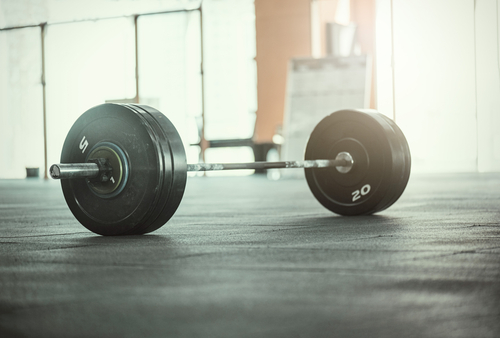
What To Look For In a Barbell
Whether you’re looking for something to improve your deadlift, continue your workout at home from the gym, or you’re just getting started, there are a few key things to focus on when it comes to deciding what type of barbell you want.
#1. Steel Quality
The first thing you should really care about with any barbell is the steel. And when we say “steel quality,” that’s not the whole story. Unless you’re buying something cheap from overseas, the steel itself isn’t the real problem. What matters is steel strength, that’s where the game is won or lost.
Steel strength is all about two things: weight-bearing capacity and tensile strength. Weight-bearing capacity is simple. It’s how much weight your bar can handle at one time without bending or failing. Most manufacturers list the total, not per side. So if you see a bar rated at 700 pounds, that means about 350 pounds per sleeve before you’re pushing the limit.
Tensile strength is a little different. It’s not just about the weight on the bar right now, it’s about the bar’s ability to hold up over years of loading and unloading. Every time you rack it heavy, the steel takes a little beating. Using that same 700-pound bar example, if you load it, unload it, and then load it again, you’ve already put 1,400 pounds of cumulative strain into it. That wear adds up.
Bottom line, you want both numbers to be as high as possible. More capacity means you can push your limits without fear. More tensile strength means the bar will last for years without warping or giving out. Get those two things right, and you’ll have a bar that stays in your hands, not in the scrap pile.
#2. Knurling
Knurling might have been a completely new term before now, and that’s fine. It’s just the textured pattern etched into the bar where your hands go. Sounds simple, but it’s one of the most important parts of a barbell. Without it, your grip can slip way too easily, and that’s how bars get dropped, plates go flying, and workouts turn into injury stories.
Outside of steel strength, knurling is the thing you should care about most. You need it sharp enough to lock into your hands so the bar stays put, but not so sharp that it chews your skin up after a few sets. Too mild and the bar will start slipping when things get heavy. Too aggressive and you’ll be nursing torn calluses instead of hitting your next lift.
The sweet spot is that middle ground where the bar feels secure but still lets you train without shredding your hands every time you touch it. Get that right, and you’ll have a bar you actually want to grab, set after set, year after year.
#3. Spin
Spin, while fairly important, isn’t quite as serious as the other two points listed. Essentially, spin relates to the reduction of centrifugal force on the weight plates when lifting them. It’s also useful when performing cleans and deadlifts.
While spins are important, you don’t need them to be too crazy. Just a reasonable amount when lifting the bar should be fine.
#4. Coating Finish
Coating, like spinning, is important up to a point. Certainly the higher grade the better, but you shouldn’t throw away a good barbell just because it doesn’t have the right finish.
Essentially, coating finish is the material they use to coat the barbell. This helps prevent scratching which can result in oxidative corrosion and rust. Odds are every barbell, regardless of what is claimed, will have some level of scratches, rust, or corrosion affect their bar at some point.
These materials do wear at the barbell’s overall longevity, though it isn’t that big of a problem so long as you’re vigilant and quick to respond to any rust you come across.
#5. Price
Next up is the price. Price is very important. You want to be mindful of your budget while also tending to stay on anything between $150-200 and higher. Keep in mind that the lower you go on price, the more you’ll have to likely forfeit in terms of quality. And, unlike many other things, a lack of quality can potentially result in a lack of barbell integrity, meaning that a good barbell is also a safe barbell.
#6. Warranty
Lastly, the warranty is a great rubber stamp of approval for the bar. If your bar has a warranty, that means the company knows and understands the value of what they’ve offered and is willing to stand by its product with money on the line.
The longer the warranty is good, the higher quality the barbell is. No one is insuring against junk.
Closing Statements
A lot of people out the think all barbells are the same, but that simply is not the case. If you’re looking to buy a barbell for your home gym, there are a few key factors you need to keep in mind: weight capacity and tensile strength, knurling, spin, coating finish, price, and warranty.
All of these factors will come into play when deciding which barbell is the best for you and your home gym. With that being said, the best barbells for home gyms are typically between $150-200 and have a warranty of at least 2 years. Now get out there and buy yourself a barbell!

Ryan is a former college wrestler and lifelong fitness fanatic with over 25 years in the industry. He’s run half marathons, tackled mud runs, placed in body transformation contests, and coached everything from wrestling to girls’ soccer.
Along the way, he’s tested hundreds of supplements and built a deep well of supplement knowledge. His work has appeared in Muscle & Strength, Testosterone Junkie, The Sport Review, and more. Today, he’s the editor-in-chief of this site, still training hard and helping others reach their goals. Connect with him on LinkedIn below.
